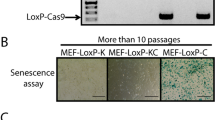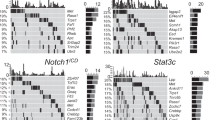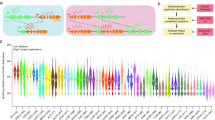Abstract
Oncogenesis is a progressive process often involving collaboration between various oncogenes and tumor suppressors. To identify those genes that collaborate with oncogenic ras, we took advantage of the Tg.AC transgenic mouse, a line that harbors the v-Ha-ras transgene and spontaneously develops an array of malignant tumors. By crossing Tg.AC mice on an inbred FVB background to other inbred strains, F1 mice were created that could be analysed using genome wide, single nucleotide polymorphism (SNP) screens. Loss of heterozygosity (LOH) in tumors and tumor cell lines marked a somatic event, possibly the inactivation of tumor suppressor gene(s). LOH could also represent DNA damage, a sign of genomic instability in the pretransformed cell. Nonetheless, the screens showed no evidence of such generalized genomic instability. Instead, they revealed a single region of LOH on chromosome 4 that occurred via somatic recombination/gene conversion, generating a region of isoparental disomy. This LOH provided a clue that linked v-Ha-ras to the inactivation of the Ink4a locus in 25 of 32 tumor cell lines. This collaboration is seen regardless of tumor type or genetic background. In contrast, tumors that develop in bitransgenic mice bearing both the v-Ha-ras gene and a heterozygous mutant p53 allele tend to retain the Ink4a locus and instead lose the p53 wild-type allele. This suggests that different strategies can be selected to collaborate with v-Ha-ras in tumorigenesis.
This is a preview of subscription content, access via your institution
Access options
Subscribe to this journal
Receive 50 print issues and online access
$259.00 per year
only $5.18 per issue
Buy this article
- Purchase on Springer Link
- Instant access to full article PDF
Prices may be subject to local taxes which are calculated during checkout







Similar content being viewed by others
References
Aguirre AJ, Bardeesy N, Sinha M, Lopez L, Tuveson DA, Horner J et al. (2003). Activated Kras and Ink4a/Arf deficiency cooperate to produce metastatic pancreatic ductal adenocarcinoma. Genes Dev 17: 3112–3126.
Beausejour CM, Krtolica A, Galimi F, Narita M, Lowe SW, Yaswen P et al. (2003). Reversal of human cellular senescence: roles of the p53 and p16 pathways. EMBO J 22: 4212–4222.
Ben-Porath I, Weinberg RA . (2005). The signals and pathways activating cellular senescence. Int J Biochem Cell Biol 37: 961–976.
Berger JH, Bardeesy N . (2007). Modeling INK4/ARF tumor suppression in the mouse. Curr Mol Med 7: 63–75.
Campbell PM, Der CJ . (2004). Oncogenic Ras and its role in tumor cell invasion and metastasis. Semin Cancer Biol 14: 105–114.
Campisi J . (2005). Senescent cells, tumor suppression, and organismal aging: good citizens, bad neighbors. Cell 120: 513–522.
Cardiff RD, Leder A, Kuo A, Pattengale PK, Leder P . (1993). Multiple tumor types appear in a transgenic mouse with the ras oncogene. Am J Pathol 142: 1199–1207.
Chin L, Pomerantz J, Polsky D, Jacobson M, Cohen C, Cordon-Cardo C et al. (1997). Cooperative effects of INK4a and ras in melanoma susceptibility in vivo. Genes Dev 11: 2822–2834.
Chirgwin JM, Przybyla AE, MacDonald RJ, Rutter WJ . (1979). Isolation of biologically active ribonucleic acid from sources enriched in ribonuclease. Biochemistry 18: 5294–5299.
Donehower LA, Harvey M, Slagle BL, McArthur MJ, Montgomery Jr CA, Butel JS et al. (1992). Mice deficient for p53 are developmentally normal but susceptible to spontaneous tumours. Nature 356: 215–221.
Dryja TP, Cavenee W, White R, Rapaport JM, Petersen R, Albert DM et al. (1984). Homozygosity of chromosome 13 in retinoblastoma. N Engl J Med 310: 550–553.
Gil J, Peters G . (2006). Regulation of the INK4b-ARF-INK4a tumour suppressor locus: all for one or one for all. Nat Rev Mol Cell Biol 7: 667–677.
Guan RJ, Fu Y, Holt PR, Pardee AB . (1999). Association of K-ras mutations with p16 methylation in human colon cancer. Gastroenterology 116: 1063–1071.
Humble MC, Trempus CS, Spalding JW, Cannon RE, Tennant RW . (2005). Biological, cellular, and molecular characteristics of an inducible transgenic skin tumor model: a review. Oncogene 24: 8217–8228.
Kamijo T, Weber JD, Zambetti G, Zindy F, Roussel MF, Sherr CJ . (1998). Functional and physical interactions of the ARF tumor suppressor with p53 and Mdm2. Proc Natl Acad Sci USA 95: 8292–8297.
Kamijo T, Zindy F, Roussel MF, Quelle DE, Downing JR, Ashmun RA et al. (1997). Tumor suppression at the mouse INK4a locus mediated by the alternative reading frame product p19ARF. Cell 91: 649–659.
Kelly-Spratt KS, Gurley KE, Yasui Y, Kemp CJ . (2004). p19Arf suppresses growth, progression, and metastasis of Hras-driven carcinomas through p53-dependent and -independent pathways. PLoS Biol 2: E242.
Krimpenfort P, Ijpenberg A, Song JY, van der Valk M, Nawijn M, Zevenhoven J et al. (2007). p15Ink4b is a critical tumour suppressor in the absence of p16Ink4a. Nature 448: 943–946.
Leder A, Daugherty C, Whitney B, Leder P . (1997). Mouse zeta- and alpha-globin genes: embryonic survival, alpha-thalassemia, and genetic background effects. Blood 90: 1275–1282.
Leder A, Kuo A, Cardiff RD, Sinn E, Leder P . (1990). v-Ha-ras transgene abrogates the initiation step in mouse skin tumorigenesis: effects of phorbol esters and retinoic acid. Proc Natl Acad Sci USA 87: 9178–9182.
Lin AW, Lowe SW . (2001). Oncogenic ras activates the ARF–p53 pathway to suppress epithelial cell transformation. Proc Natl Acad Sci USA 98: 5025–5030.
Linardopoulos S, Street AJ, Quelle DE, Parry D, Peters G, Sherr CJ et al. (1995). Deletion and altered regulation of p16INK4a and p15INK4b in undifferentiated mouse skin tumors. Cancer Res 55: 5168–5172.
Lukas J, Parry D, Aagaard L, Mann DJ, Bartkova J, Strauss M et al. (1995). Retinoblastoma-protein-dependent cell-cycle inhibition by the tumour suppressor p16. Nature 375: 503–506.
Moran JL, Bolton AD, Tran PV, Brown A, Dwyer ND, Manning DK et al. (2006). Utilization of a whole genome SNP panel for efficient genetic mapping in the mouse. Genome Res 16: 436–440.
Pomerantz J, Schreiber-Agus N, Liegeois NJ, Silverman A, Alland L, Chin L et al. (1998). The Ink4a tumor suppressor gene product, p19Arf, interacts with MDM2 and neutralizes MDM2's inhibition of p53. Cell 92: 713–723.
Serrano M, Lin AW, McCurrach ME, Beach D, Lowe SW . (1997). Oncogenic ras provokes premature cell senescence associated with accumulation of p53 and p16INK4a. Cell 88: 593–602.
Sharpless NE . (2005). INK4a/ARF: a multifunctional tumor suppressor locus. Mutat Res 576: 22–38.
Sherr CJ . (2006). Divorcing ARF and p53: an unsettled case. Nat Rev Cancer 6: 663–673.
Sherr CJ, McCormick F . (2002). The RB and p53 pathways in cancer. Cancer Cell 2: 103–112.
Sinn E, Muller W, Pattengale P, Tepler I, Wallace R, Leder P . (1987). Coexpression of MMTV/v-Ha-ras and MMTV/c-myc genes in transgenic mice: synergistic action of oncogenes in vivo. Cell 49: 465–475.
Tannapfel A, Benicke M, Katalinic A, Uhlmann D, Kockerling F, Hauss J et al. (2000). Frequency of p16(INK4A) alterations and K-ras mutations in intrahepatic cholangiocarcinoma of the liver. Gut 47: 721–727.
Uhrbom L, Dai C, Celestino JC, Rosenblum MK, Fuller GN, Holland EC . (2002). Ink4a-Arf loss cooperates with KRas activation in astrocytes and neural progenitors to generate glioblastomas of various morphologies depending on activated Akt. Cancer Res 62: 5551–5558.
Acknowledgements
We thank Professors Cynthia Morton and Michelle Kelliher for helpful discussions.
Author information
Authors and Affiliations
Corresponding author
Additional information
Supplementary Information accompanies the paper on the Oncogene website (http://www.nature.com/onc).
Rights and permissions
About this article
Cite this article
Leder, A., McMenamin, J., Zhou, F. et al. Genome-wide SNP analysis of Tg.AC transgenic mice reveals an oncogenic collaboration between v-Ha-ras and Ink4a, which is absent in p53 deficiency. Oncogene 27, 2456–2465 (2008). https://doi.org/10.1038/sj.onc.1210866
Received:
Revised:
Accepted:
Published:
Issue Date:
DOI: https://doi.org/10.1038/sj.onc.1210866
Keywords
This article is cited by
-
PIG11 is Involved in Hepatocellular Carcinogenesis and Its Over-expression Promotes Hepg2 Cell Apoptosis
Pathology & Oncology Research (2009)



